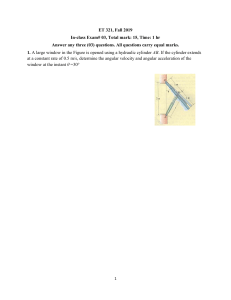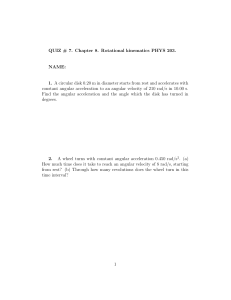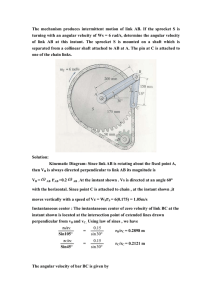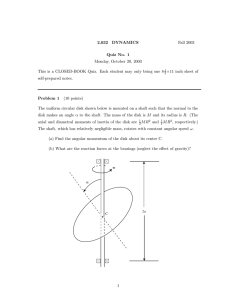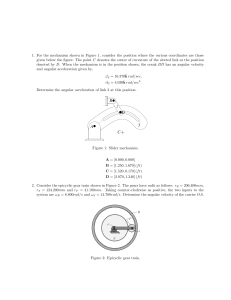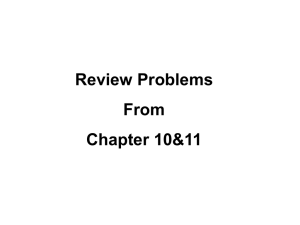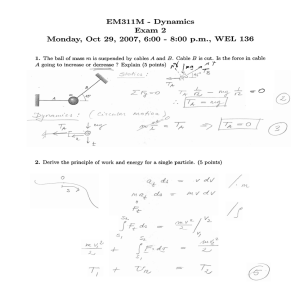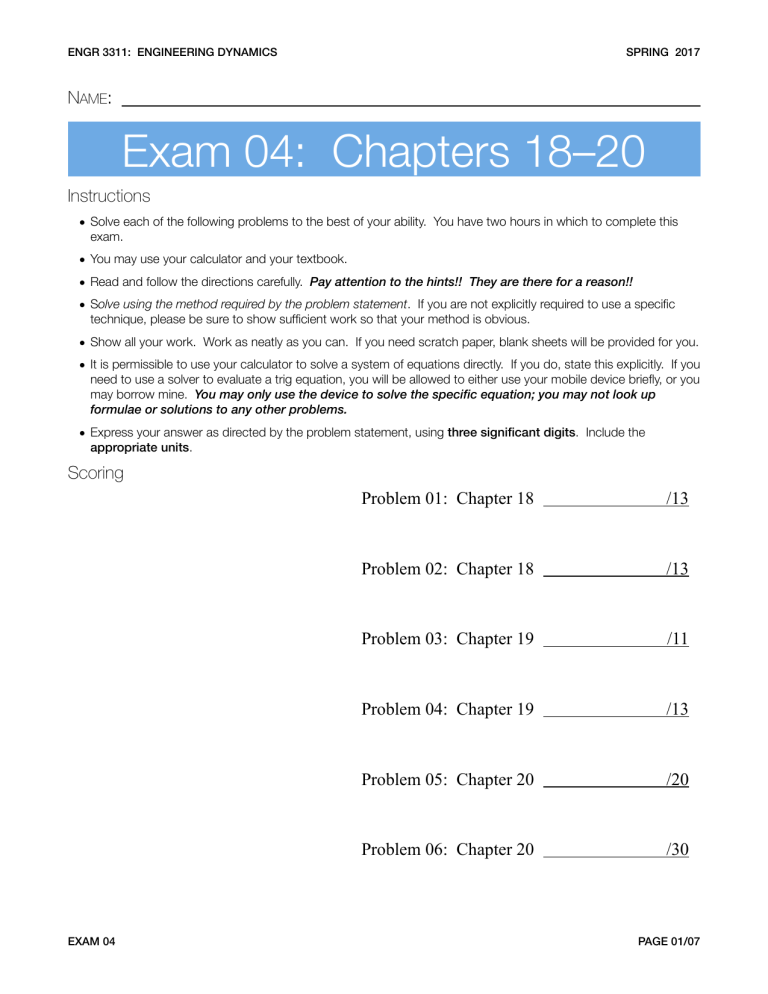
ENGR 3311: ENGINEERING DYNAMICS! SPRING 2017 NAME: Exam 04: Chapters 18–20 Instructions • Solve each of the following problems to the best of your ability. You have two hours in which to complete this exam. • You may use your calculator and your textbook. • Read and follow the directions carefully. Pay attention to the hints!! They are there for a reason!! • Solve using the method required by the problem statement. If you are not explicitly required to use a specific technique, please be sure to show sufficient work so that your method is obvious. • Show all your work. Work as neatly as you can. If you need scratch paper, blank sheets will be provided for you. • It is permissible to use your calculator to solve a system of equations directly. If you do, state this explicitly. If you need to use a solver to evaluate a trig equation, you will be allowed to either use your mobile device briefly, or you may borrow mine. You may only use the device to solve the specific equation; you may not look up formulae or solutions to any other problems. • Express your answer as directed by the problem statement, using three significant digits. Include the appropriate units. Scoring EXAM 04! Problem 01: Chapter 18 /13 Problem 02: Chapter 18 /13 Problem 03: Chapter 19 /11 Problem 04: Chapter 19 /13 Problem 05: Chapter 20 /20 Problem 06: Chapter 20 /30 PAGE 01/07 ENGR 3311: ENGINEERING DYNAMICS! Problem 01 SPRING 2017 Chapter 18: Problem 18.24 The disk (m = 30kg) shown is originally at rest, and the spring (k = 200N/ m) is unstretched. A couple moment M = 80 N·m is then applied to the disk as shown. Determine its angular velocity ω when its mass center G has moved s = 0.5 m horizontally. The disk rolls without slipping. Hint: Nothing tricky here; s = rθ relates linear translation to rotation of disk, and U = Mθ for the applied torque. Don’t forget the spring! EXAM 04! PAGE 02/07 ENGR 3311: ENGINEERING DYNAMICS! Problem 02 SPRING 2017 Chapter 18: Problem 18.60 The pendulum consists of a slender rod (mAB = 6 kg) fixed to a disk (mD = 15 kg). If the spring (k = 200 N/m) has an unstretched length lo = 0.2 m, determine the angular velocity of the pendulum when it is released from rest and rotates clockwise 90° from the position shown. The roller at C allows the spring to always remain vertical. Hint: Pure rotational KE with respect to point B, so be careful with your moment of inertia! For gravitational PE, let h = 0 at point B. Both have negative PE at point 2. hAB = –0.5m and hD = –1.3m For spring PE: s1 = (l1 – lo) = (0.5 – 0.2)m and s2 = (l2 - lo) = (1.0 – 0.2)m For KE, treat rod AB and disk D as a single unit, calculate IB: KE2 = ½IBω2 EXAM 04! PAGE 03/07 ENGR 3311: ENGINEERING DYNAMICS! Problem 03 SPRING 2017 Chapter 19: Problem 19.39 Rod AB (mAB = 12 kg) is pinned at B to disk D (mD = 40 kg). The disk is given an angular velocity ωD = 100 rad/s while the rod is held stationary. The assembly is then released. Determine the angular velocity ωA of the rod after the disk has stopped spinning relative to the rod due to frictional resistance at the bearing B. Hint: Motion is in the horizontal plane. Neglect friction at pin A. This is almost identical to the problem we set up in class, except A is unambiguously pinned and stationary. Because bearing friction is internal to the system, conserve angular momentum. EXAM 04! PAGE 04/07 ENGR 3311: ENGINEERING DYNAMICS! SPRING 2017 Problem 04 Chapter 19: Problem 19.58 The pendulum consists of a 10-lb solid ball and 4-lb rod. If it is released from rest when θ0 = 0°, determine the angle θ of rebound after the ball strikes the wall and the pendulum swings up to the point of momentary rest. Take e = 0.6. Hint: The vertical version of Problem 19.56 that we set up in class! Conserve energy, conserve momentum (use restitution), conserve energy. Position 0: Initial release at θo = 0°; let h = 0 at point A Position 1: Instant just before impact Position 2: Instant just after collision Position 3: Highest position of pendulum after rebound EXAM 04! PAGE 05/07 ENGR 3311: ENGINEERING DYNAMICS! Problem 05 SPRING 2017 Chapter 20: Problem 20.6 The conical spool rolls on the plane without slipping. If the axle has an angular velocity ω1 = 3 rad/s and an angular acceleration α1 = 2 rad/s2 at the instant shown, determine the angular velocity ω2 and angular acceleration α2 of the spool at this instant. Hint: Like the one we did in class, only a little easier; you just need to find ω2 and α2, not v and a of a point on the rim. Remember that the resultant angular velocity ω = ω1 + ω2 is always directed along the instantaneous axis of zero velocity (–y axis, in this case B is the instantaneous center, and ω = –ωj). Also, because the instantaneous axis is in the xy-plane, there can be no z-component for the angular acceleration α (but you should be able to see that it can have both x-and/or y-components!). EXAM 04! PAGE 06/07 ENGR 3311: ENGINEERING DYNAMICS! SPRING 2017 Problem 06 Chapter 20: Problem 20.54 z, z’’ Z, z’ x, x’’ X, x’ Y, y’ EXAM 04! At the instant shown, the arm AB is rotating about the fixed bearing at A with an angular velocity ω1 = 2 rad/s and (ω·)1 = 6 rad/s2. At the same instant, rod BD is rotating relative to rod AB at ω2 = 7 rad/s, which is increasing at (ω·)2 = 1 rad/s2. Just for extra fun, the collar C is moving along rod BD with a speed (r·) = 2 ft/s and and acceleration (r··) = –0.5 ft/s2, both measured relative to point B. y, y’’ Determine the velocity and acceleration of the collar at this instant. Hint: This sets up almost exactly like Example 20.5 from the text! • • • • Fixed axes X,Y,Z at O as shown on the figure Let x,y,z originate at B, which means that Ω = ω1 and Ωxyz = ω2 The x’,y’,z’ axes rotate with Ω’ = ω1 The x”,y”,z” axes rotate with Ωxyz = ω2 PAGE 07/07
